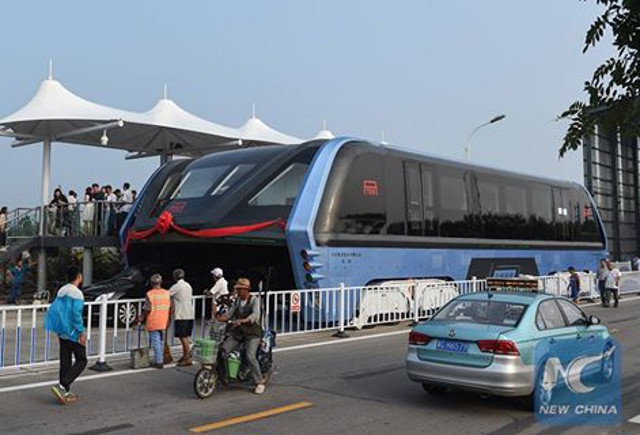
September 2, 2016, by Tony Hong
The ‘straddling’ bus: a solution for China’s eco-woes?
By Gareth Shaw, PhD Candidate.
From the School of Sociology and Social Policy at the University of Nottingham UK.
China’s air pollution problems are world-renowned, with the country playing host to eight of the top 50 locations in the world with the worst air quality in 2016[1]. Contributing significantly to this figure is China’s on-going love affair with the automobile, with an estimated 18 million cars being added to China’s roads per annum[2]. Intense traffic in China’s metropolises is commonplace, and solutions to combat both worsening air pollution and the urban gridlock are becoming increasingly inventive.
Back in May 2016, video clips[3] emerged from China showing a model for a proposed traffic congestion alleviation scheme, whereby large ‘bus’ capsules would ‘straddle’ over the top of moving (or more likely, stationary) traffic. The design, known as the Transit Elevated Bus (TEB), or巴铁 in Chinese, attracted both frenzied interest and a mild incredulity as to how such a vehicle could ever work in practice. Yet, just three short months later, China has unveiled a full working version on a 300m test track in Qinhuangdao, Hebei. The concept of the TEB is not a new one, having first been proposed in 1969[4], but until recently the idea had remained firmly on the drawing board. Consisting of individual elevated electrically-powered passenger units measuring 21m by 7m, capable of carrying 300 passengers each[5], which can be linked in ‘trains’ of up to four units[6], these vehicles will theoretically allow 1,200 passengers to sail freely 2 meters above the traffic at speeds of up to 60kph along tracks installed on pre-existing roads. The proposed traffic solution would cost just one fifth of the expense of building an equivalent subway line[7].
Many observers have been quick to point out the scheme’s potential flaws, primarily concerning the interaction between the vast people carriers and the free-flowing traffic passing beneath. Given an operating height of just 2 meters, heavy goods vehicles and even some lager SUVs would stop the buses in their tracks. There are also safety concerns as to how drivers may react as the bus hurtles overhead[8], which will entirely encase 21 meters of the road at a time, affecting both light levels and peripheral vision. As anyone who has driven around China’s major cities can testify, lane discipline on China’s roads is more of an art form than a science, yet videos[9] show the buses running on track ways sunk directly into the road surface, like urban tram tracks. In light of this increased potential for RTAs, some weibo users have suggested that the buses should travel in a contrary direction to the traffic over which it flows, to give motorists adequate warning of its arrival. One of the key design features of the elevated bus is its ability to pass over standing lines of traffic, yet there will doubtless be times in the day when the traffic is free-flowing, leading to increased psychological pressure on motorists[10], not to mention cyclists or riders of China’s ubiquitous e-bikes.
So, is the TEB a mere flight of fancy? Will it pass into the annals of history in the same way as the Shanghai Maglev Train, which showcased cutting-edge experimental technology, but yet which was never expanded beyond the confines of its initial 30km track? Or does the 巴铁 represent a practical solution to China’s mounting traffic pollution problems. Of that, only time will tell. But the apparent speed of progress from concept model to test run has once again focused attention upon the break-neck speed of progress within China’s infrastructure development.
[1] http://www.huffingtonpost.com/entry/air-pollution-2016-world-health-organization_us_5735275ee4b077d4d6f2b165
[2] http://blogs.wsj.com/chinarealtime/2015/12/02/china-road-rage-cases-top-17-million-so-far-in-2015/
[3] http://v.youku.com/v_show/id_XMTU3NjU2OTQ0NA==.html?from=s1.8-1-1.2
[4] http://www.citylab.com/tech/2016/05/can-chinas-futuristic-straddling-bus-finally-become-a-reality/483953/
[5] http://www.bbc.co.uk/news/world-asia-china-36961433
[6] https://www.wired.com/2016/08/concerns-chinas-traffic-slaying-straddling-bus/
[7] http://europe.newsweek.com/chinas-elevated-bus-gets-first-road-test-486752?rm=eu
[8] http://www.techtimes.com/articles/172367/20160803/riding-in-style-chinas-futuristic-straddling-bus-is-elevated-to-travel-above-car-traffic.htm
[9] http://v.youku.com/v_show/id_XMTY2OTIwNjgwNA==.html?from=s1.8-1-1.2
[10] http://zqb.cyol.com/html/2016-07/05/nw.D110000zgqnb_20160705_1-09.htm
No comments yet, fill out a comment to be the first

Leave a Reply